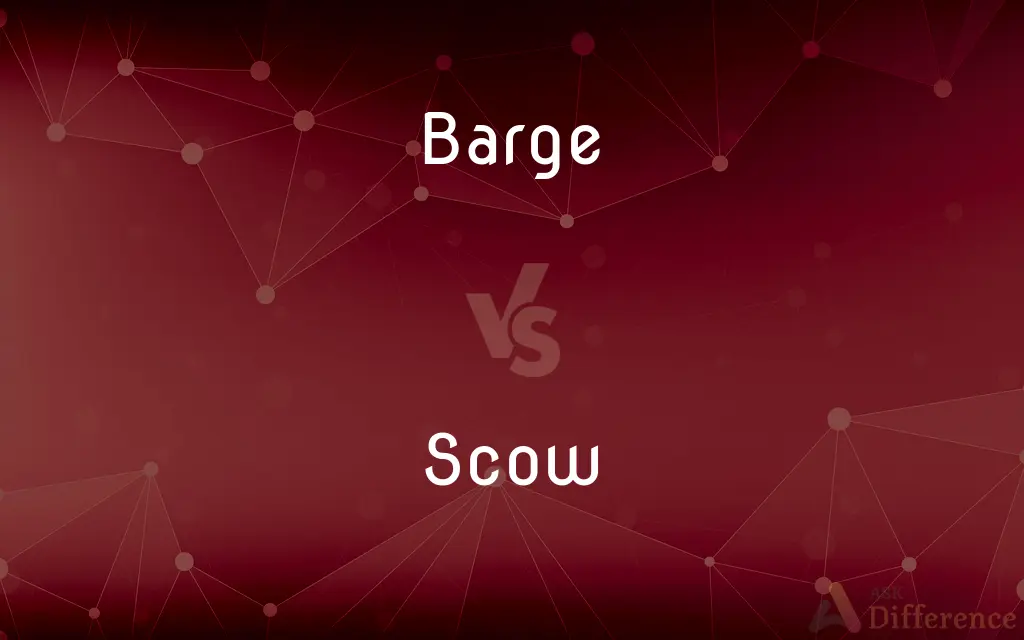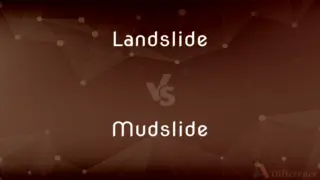Barge vs. Scow — What's the Difference?
By Tayyaba Rehman & Fiza Rafique — Updated on April 14, 2024
A barge is a flat-bottomed boat designed primarily for river and canal transport of heavy goods, while a scow is a broader, flat-bottomed vessel often used for carrying bulk materials, typically more associated with coastal and shallow waters.

Difference Between Barge and Scow
Table of Contents
ADVERTISEMENT
Key Differences
Barges are commonly used in inland waterways, designed for efficient transport of goods along rivers and canals. They are often towed or pushed by tugboats, focusing on long-distance, high-capacity transport. On the other hand, scows are versatile flat-bottomed boats with a blunt bow, more frequently used in coastal waters and for tasks such as dredging or carrying construction materials.
Barges are generally equipped to handle larger and heavier loads, making them crucial in commercial trade, especially for materials like coal, grain, and other bulk commodities. Scows, whereas, are typically smaller and less capable in terms of load capacity but are prized for their ability to navigate shallow and narrow bodies of water.
Construction-wise, barges are built for strength and durability, often made of steel and designed to endure the rigors of long river journeys. Scows, on the other hand, might be constructed with lighter materials and have a more open design to facilitate easy loading and unloading of materials like sand or gravel.
In terms of operability, barges often require external propulsion from tugboats or towboats, as they are not typically equipped with their own means of movement. Scows may also be towed but can be rigged with sails or simple motor systems, allowing for greater independence in movement.
The usage context of barges extends into the transportation of liquid cargo via tank barges, which are specially designed for that purpose. Scows, however, are seldom used for liquid cargo, focusing instead on solid bulk or support for marine construction projects.
ADVERTISEMENT
Comparison Chart
Design
Long and narrow, optimized for river navigation
Broader and flatter, suitable for shallow waters
Usage
Heavy goods transport in inland waterways
Bulk materials transport in coastal and shallow waters
Construction
Strong, durable, usually steel
Lighter, may be more open for easy loading/unloading
Propulsion
Requires external towing by tugboats
May have sails or simple motors for independent movement
Typical Cargo
Coal, grain, tank (liquids)
Sand, gravel, construction materials
Compare with Definitions
Barge
Utilized for bulk commodity transport, barges are crucial in commercial trade.
The steel barge transported coal to the power plant.
Scow
A flat-bottomed boat with a blunt bow, often used in coastal waters.
The scow moved sand from the shore to the construction site.
Barge
A long, flat-bottomed boat used in inland waterways for transporting goods.
The barge carried tons of grain down the Mississippi.
Scow
Scows are versatile and used for various tasks including dredging.
The scow was deployed for the dredging project near the bay.
Barge
Often towed by a tug, barges are integral to river transport.
A tugboat towed the barge upstream.
Scow
Focused on carrying solid bulk materials.
The gravel was loaded onto the scow at the dock.
Barge
Designed for efficient, high-capacity transport.
The cargo barge can hold up to 1500 tons.
Scow
Typically smaller and lighter than barges.
The small scow could easily navigate the shallow waters.
Barge
Can be specialized as tank barges for liquid transport.
The tank barge was filled with crude oil.
Scow
May have its own simple propulsion system.
The motorized scow made short trips along the coast.
Barge
A barge is a shoal-draft flat-bottomed boat, built mainly for river and canal transport of bulk goods. Originally barges were towed by draft horses on an adjacent towpath.
Scow
A scow is a type of flat-bottomed barge. Some scows are rigged as sailing scows.
Barge
A long, large, usually flatbottom boat for transporting freight that is generally unpowered and towed or pushed by other craft.
Scow
A large flatbottom boat with square ends, used chiefly for transporting freight.
Barge
A large, open pleasure boat used for parties, pageants, or formal ceremonies.
Scow
A large flat-bottomed boat, having broad, square ends.
Barge
A powerboat reserved for the use of an admiral.
Scow
(transitive) To transport in a scow.
Barge
To carry by barge.
Scow
A large flat-bottomed boat, having broad, square ends.
Barge
To move about clumsily.
Scow
To transport in a scow.
Barge
To intrude or interrupt, especially rudely
Barged into the meeting.
Scow
Any of various flat-bottomed boats with sloping ends
Barge
A large flat-bottomed towed or self-propelled boat used mainly for river and canal transport of heavy goods or bulk cargo.
Scow
A barge carrying bulk materials in an open hold
Barge
A richly decorated ceremonial state vessel propelled by rowers for river processions.
Barge
A large flat-bottomed coastal trading vessel having a large spritsail and jib-headed topsail, a fore staysail and a very small mizen, and having leeboards instead of a keel.
Barge
One of the boats of a warship having fourteen oars
Barge
The wooden disk in which bread or biscuit is placed on a mess table.
Barge
(US) A double-decked passenger or freight vessel, towed by a steamboat.
Barge
A large omnibus used for excursions.
Barge
To intrude or break through, particularly in an unwelcome or clumsy manner.
Barge
(transitive) To push someone.
Barge
A pleasure boat; a vessel or boat of state, elegantly furnished and decorated.
Barge
A large, roomy boat for the conveyance of passengers or goods; as, a ship's barge; a charcoal barge.
Barge
A large boat used by flag officers.
Barge
A double-decked passenger or freight vessel, towed by a steamboat.
Barge
A large omnibus used for excursions.
Barge
A flatbottom boat for carrying heavy loads (especially on canals)
Barge
Push one's way;
She barged into the meeting room
Barge
Transport by barge on a body of water
Common Curiosities
How do barges and scows differ in design?
Barges are typically long and narrow, while scows are broader and flatter.
Can barges move on their own?
No, barges usually require external propulsion, such as from a tugboat.
What is a barge?
A barge is a flat-bottomed vessel designed for transporting heavy goods, especially on inland waterways.
What kind of cargo do barges typically carry?
Barges often carry bulk commodities like coal, grain, or even liquids in tank barges.
What materials are scows constructed from?
Scows can be constructed from various materials, including lighter ones, to facilitate easy loading and unloading.
What is a scow?
A scow is a flat-bottomed boat used primarily for transporting bulk materials in coastal and shallow waters.
Are scows capable of independent movement?
Yes, some scows are equipped with sails or motors for independent movement.
How are barges constructed?
Barges are generally constructed from steel, making them strong and durable.
Can scows carry liquid cargo?
It is uncommon for scows to carry liquid cargo; they are primarily used for solid bulk materials.
Where are barges mainly used?
Barges are mainly used in rivers and canals for inland transport.
Where are scows mainly used?
Scows are mainly used in coastal and shallow waters.
What cargo are scows suited for?
Scows are often used to transport materials like sand, gravel, and are useful in construction projects.
What is the typical size of a barge compared to a scow?
Barges are usually larger and have a higher capacity compared to scows.
What makes a barge suitable for river transport?
The design of a barge, being long and narrow, is optimized for navigating through rivers and canals.
Why are scows preferred in shallow waters?
The flat and broad design of scows makes them ideal for navigating and working in shallow waters.
Share Your Discovery

Previous Comparison
Chorus vs. Unison
Next Comparison
Landslide vs. MudslideAuthor Spotlight
Written by
Tayyaba RehmanTayyaba Rehman is a distinguished writer, currently serving as a primary contributor to askdifference.com. As a researcher in semantics and etymology, Tayyaba's passion for the complexity of languages and their distinctions has found a perfect home on the platform. Tayyaba delves into the intricacies of language, distinguishing between commonly confused words and phrases, thereby providing clarity for readers worldwide.
Co-written by
Fiza RafiqueFiza Rafique is a skilled content writer at AskDifference.com, where she meticulously refines and enhances written pieces. Drawing from her vast editorial expertise, Fiza ensures clarity, accuracy, and precision in every article. Passionate about language, she continually seeks to elevate the quality of content for readers worldwide.
















































